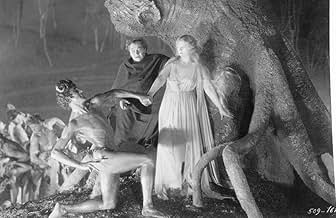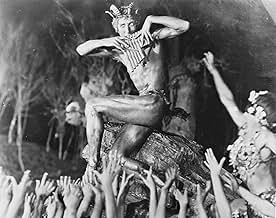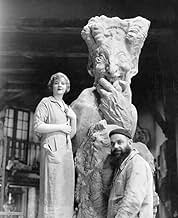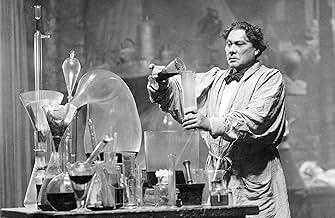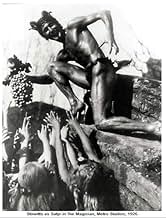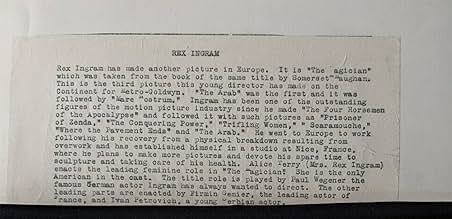Agrega una trama en tu idiomaA magician/alchemist, seeking to create life, finds that he needs the "blood of a virgin" to continue his experiments. He sends out his dwarf assistant to pick out the right girl.A magician/alchemist, seeking to create life, finds that he needs the "blood of a virgin" to continue his experiments. He sends out his dwarf assistant to pick out the right girl.A magician/alchemist, seeking to create life, finds that he needs the "blood of a virgin" to continue his experiments. He sends out his dwarf assistant to pick out the right girl.
- Dirección
- Guionistas
- Elenco
Hubert I. Stowitts
- Dancing Faun
- (as Stowitts)
Claude Fielding
- Dancing Faun
- (sin créditos)
Gerald Fielding
- Dancing Faun
- (sin créditos)
Rosita Garcia
- Arab Girl Bitten by Snake
- (sin créditos)
John George
- Haddo's Dwarf Servant
- (sin créditos)
Michael Powell
- Man with Balloon at Snake Charming
- (sin créditos)
- Dirección
- Guionistas
- Todo el elenco y el equipo
- Producción, taquilla y más en IMDbPro
Opiniones destacadas
Rex Ingram is probably best remembered for directing Rudolph Valentino's breakthrough film THE FOUIR HORSEMEN OF THE APOCALYPSE (1921) but he ventured into the fledgling terror genre with this thriller starring Paul (The Golem) Wegener.
Wegener's character, Dr. Oliver Haddo, is allegedly based on the real life character Alastair Crowley. When we first meet him he is in attendance as the famous Dr. Burdon (Ivan Petrovich) saves the life of lovely Margaret Dauncey (Alice Terry, the real life Mrs. Ingram) with an operation on her spine. While recovering, Margaret falls in love with Dr. Burdon and he returns her affections. Dr. Haddo is interested in her too but for far less healthy reasons. Dr. H you see, has been searching for the way to create artificial life in the laboratory (sound familiar?) and a old book on alchemy has informed him that he needs "the heart blood of a maiden" added to certain other chemicals to make this happen.
So determined is Haddo to make this happen that he hypnotises Margaret and marries her while she is under his spell. At his mountain top lab he plans to complete his diabolical experiment. Will Margaret lose her own life so Haddo can create life? Will Dr. Burdon find her in time? Ah . . . that would be telling!
What many of us wonder is, is Haddo a real magician or just a very good hypnotist? In one scene he allows a poisonous snake to bite him but makes the lethal wound vanish with just a wave of his hand. Just a moment later the same snake bites a young woman and she must be rushed to hospital. Now most of us know that a venomous snake expels all its venom at the first bite so the fact that it was the second bite that felled the woman should have been a tipoff that Haddo was not bitten at all. Yes, but remember this is a movie and we have to build up suspense. An amusing scene has Dr. Burdon and Dr. Haddo meeting for the first time in a park. As Haddo walks away Burdon remarks to Margaret "He looks like he stepped out of a melodrama!". As if on cue Haddo glares back, throws his cape over his shoulder and makes a perfect stage exit! It is an innocuous but effective moment and briefly clouds the menace that will soon be facing the lovers.
The sequence most people remember is where Haddo gives Margaret a look at Hell. It is a rugged looking place but rather removed from the horrors of the Italian film L'INFERNO (1909) or even DANTE'S INFERNO (1926). The place is loaded with damned souls but they all dance around carefree while Pan (at least I think it's Pan) plays a tune on his pipes. Another faun (dancer Hubert Stowitts) takes Margaret in his arms and passionately kisses her as the dream ends. So did they really go to Hell or was it all a hypnotic dream? In a key scene soon after this Haddo visits Margaret at her home and we clearly see his lips say the words "your rape" which sends her into the deepest despair. Whether the rape was actual or just implied quickly becomes a moot point because she goes away with him, convinced she can never marry Dr. Burdon now.
Elements of the final reels of THE MAGICIAN figure prominently in the Universal film FRANKENSTEIN (1931). Haddo has a monolithic castle at the top of a mountain, a dwarf assistant do you think his name is Fritz?) and a well equipped lab. I think that not only director James Whale but also the set designer for FRANKENSTEIN had to have sat through this film more than once.
Talkies came along about a year after this film was completed and Wegener, who was uncertain of his ability to speak English, returned to Germany. He was not alone, he was soon joined by Emil Jannings, Conrad Veidt and several other actors who had their doubts about being able to effectively perform in a foreign (to them)language.
So is THE MAGICIAN worth seeing? Yes it is, despite its shortcomings it is a well paced and convincingly performed thriller. Give it a try.
Wegener's character, Dr. Oliver Haddo, is allegedly based on the real life character Alastair Crowley. When we first meet him he is in attendance as the famous Dr. Burdon (Ivan Petrovich) saves the life of lovely Margaret Dauncey (Alice Terry, the real life Mrs. Ingram) with an operation on her spine. While recovering, Margaret falls in love with Dr. Burdon and he returns her affections. Dr. Haddo is interested in her too but for far less healthy reasons. Dr. H you see, has been searching for the way to create artificial life in the laboratory (sound familiar?) and a old book on alchemy has informed him that he needs "the heart blood of a maiden" added to certain other chemicals to make this happen.
So determined is Haddo to make this happen that he hypnotises Margaret and marries her while she is under his spell. At his mountain top lab he plans to complete his diabolical experiment. Will Margaret lose her own life so Haddo can create life? Will Dr. Burdon find her in time? Ah . . . that would be telling!
What many of us wonder is, is Haddo a real magician or just a very good hypnotist? In one scene he allows a poisonous snake to bite him but makes the lethal wound vanish with just a wave of his hand. Just a moment later the same snake bites a young woman and she must be rushed to hospital. Now most of us know that a venomous snake expels all its venom at the first bite so the fact that it was the second bite that felled the woman should have been a tipoff that Haddo was not bitten at all. Yes, but remember this is a movie and we have to build up suspense. An amusing scene has Dr. Burdon and Dr. Haddo meeting for the first time in a park. As Haddo walks away Burdon remarks to Margaret "He looks like he stepped out of a melodrama!". As if on cue Haddo glares back, throws his cape over his shoulder and makes a perfect stage exit! It is an innocuous but effective moment and briefly clouds the menace that will soon be facing the lovers.
The sequence most people remember is where Haddo gives Margaret a look at Hell. It is a rugged looking place but rather removed from the horrors of the Italian film L'INFERNO (1909) or even DANTE'S INFERNO (1926). The place is loaded with damned souls but they all dance around carefree while Pan (at least I think it's Pan) plays a tune on his pipes. Another faun (dancer Hubert Stowitts) takes Margaret in his arms and passionately kisses her as the dream ends. So did they really go to Hell or was it all a hypnotic dream? In a key scene soon after this Haddo visits Margaret at her home and we clearly see his lips say the words "your rape" which sends her into the deepest despair. Whether the rape was actual or just implied quickly becomes a moot point because she goes away with him, convinced she can never marry Dr. Burdon now.
Elements of the final reels of THE MAGICIAN figure prominently in the Universal film FRANKENSTEIN (1931). Haddo has a monolithic castle at the top of a mountain, a dwarf assistant do you think his name is Fritz?) and a well equipped lab. I think that not only director James Whale but also the set designer for FRANKENSTEIN had to have sat through this film more than once.
Talkies came along about a year after this film was completed and Wegener, who was uncertain of his ability to speak English, returned to Germany. He was not alone, he was soon joined by Emil Jannings, Conrad Veidt and several other actors who had their doubts about being able to effectively perform in a foreign (to them)language.
So is THE MAGICIAN worth seeing? Yes it is, despite its shortcomings it is a well paced and convincingly performed thriller. Give it a try.
In Paris, beautiful sculptress Alice Terry (as Margaret Dauncey) is critically wounded when a giant faun she is working on cracks, topples, and crushes her body. Ms. Terry's wealthy uncle summons American surgeon Ivan Petrovich (as Arthur Burdon) to operate on Terry's paralyzed body. The doctor and patient celebrate Terry's full recovery by falling in love. During their courtship, they encounter magician hypnotist Paul Wegener (as Oliver Haddo), an alchemist who witnessed Terry's miraculous surgery. A frightening, rotund man, Mr. Wegener happens to encounter Dr. Petrovich and Terry again and again. Wegener wants to create life, and has decided Terry will supply the "Blood of a Maiden" required in an ancient sorcerer's recipe!
While still a young woman, Terry seems more like a matron than a maiden - guess you just have to assume "The Magician" knows a virgin when he sees one. In W. Somerset Maugham's original novel, the Terry character is a teenaged art student, and the intriguing Gladys Hamer (as Susie Boyd) an older rival; it's an excellent read, and fairly easy to find on line (for free). Most unclear, in the film, is exactly how Wegener's experiment is supposed to work. Playing "Dr. Frankenstein" (and inspiring the 1931 classic's design), Wegener sets up a lab to extract blood, apparently. Highlighted by a hellish hallucination, it's very nicely envisioned by Terry's skillful director husband Rex Ingram; but, it lacks the richness of plot abundantly available in the book.
****** The Magician (10/24/26) Rex Ingram ~ Alice Terry, Paul Wegener, Ivan Petrovich, Firmin Gemier
While still a young woman, Terry seems more like a matron than a maiden - guess you just have to assume "The Magician" knows a virgin when he sees one. In W. Somerset Maugham's original novel, the Terry character is a teenaged art student, and the intriguing Gladys Hamer (as Susie Boyd) an older rival; it's an excellent read, and fairly easy to find on line (for free). Most unclear, in the film, is exactly how Wegener's experiment is supposed to work. Playing "Dr. Frankenstein" (and inspiring the 1931 classic's design), Wegener sets up a lab to extract blood, apparently. Highlighted by a hellish hallucination, it's very nicely envisioned by Terry's skillful director husband Rex Ingram; but, it lacks the richness of plot abundantly available in the book.
****** The Magician (10/24/26) Rex Ingram ~ Alice Terry, Paul Wegener, Ivan Petrovich, Firmin Gemier
Until a few months ago, when Michael Elliott added it to his list of films watched to be exact, I was under the impression that this was a lost title a view which was certainly true till the late 70s since Carlos Clarens, in his wonderful 1967 "Horror Movies" book, called it "probably the most elusive of lost movies" and even Leslie Halliwell, in the 1977 edition of his famous "Film Guide", gives it as unavailable for reappraisal! Indeed, virtually the only way I had previously known this film was via one intriguing still of the Hades sequence found in the section devoted to director Rex Ingram in the periodical "The Movies" (published in the early 80s)
so, it's great that THE MAGICIAN has eventually seen the light of day (albeit unofficially) and, thankfully, it lives up to its considerable reputation to my eyes, at least.
Ingram was one of Silent cinema's master visual stylists but is now a forgotten figure best-known for the Rudolph Valentino version of THE FOUR HORSEMAN OF THE APOCALYSE (1921); his retirement from films once Talkies came in suggests that, like D.W. Griffith, he was unable to adapt to the ongoing progress in cinematic technique and, indeed, his films like Griffith's have an inherently stilted quality to them which dates his output more than those of contemporary auteurs! Anyway, this was my fourth Ingram movie after the interesting THE CONQUERING POWER (1921), the fine if somewhat underwhelming THE PRISONER OF ZENDA (1922) and the rousing SCARAMOUCHE (1923); unfortunately, my copy of MARE NOSTRUM (1926) recorded off TCM UK got erased by accident before I had the opportunity to watch it. Alice Terry, Ingram's wife, appeared in 15 of his films and here plays the distressed virginal heroine who's the prime ingredient for the experiment concocted by the magician of the title (Paul Wegener). The latter, best-known for his three "Golem" pictures made at the height of the "German Expressionist" movement, makes for an overwhelmingly menacing villain although I found his being a medical student quite amusing (Wegener was 52 at the time of filming!). By the way, the character of Oliver Haddo was based by novelist W. Somerset Maugham on notorious English Occultist and writer Aleister Crowley! The film, an MGM production but shot in France (where Ingram lived), is ostensibly a variation on the Frankenstein myth with a few Svengali overtones thrown in for good measure; interestingly, Paul Wegener would star in an official version of that one in Germany the following year. Ingram's assistant director was the future iconoclastic English film-maker, Michael Powell, who also appears unbilled in a snake-charming sequence around the middle of the film! As expected, the film is pictorially quite stylish (shot by frequent Rex Ingram, Preston Sturges and Billy Wilder lenser, John F. Seitz), especially in the fantasy sequence set in Hades which must surely have left an indelible impression on Ingram's production manager here, Harry Lachman, to refer back to it when he came to direct the Spencer Tracy version of DANTE'S INFERNO (1935) and the finale set in a laboratory on a remote mountaintop, which uncannily prefigures (literally step by step) the similar climax at the end of James Whale's BRIDE OF FRANKENSTEIN (1935)!; as a matter of fact, Wegener even has a dwarfish assistant a' la Dwight Frye in Whale's FRANKENSTEIN (1931) so, it's very possible that Whale had seen Ingram's film.
One is all the more grateful, then, that a print of THE MAGICIAN has survived since it helps throw more light on the influences behind the greatest horror film ever made (which also happens to be my all-time favorite film)
Ingram was one of Silent cinema's master visual stylists but is now a forgotten figure best-known for the Rudolph Valentino version of THE FOUR HORSEMAN OF THE APOCALYSE (1921); his retirement from films once Talkies came in suggests that, like D.W. Griffith, he was unable to adapt to the ongoing progress in cinematic technique and, indeed, his films like Griffith's have an inherently stilted quality to them which dates his output more than those of contemporary auteurs! Anyway, this was my fourth Ingram movie after the interesting THE CONQUERING POWER (1921), the fine if somewhat underwhelming THE PRISONER OF ZENDA (1922) and the rousing SCARAMOUCHE (1923); unfortunately, my copy of MARE NOSTRUM (1926) recorded off TCM UK got erased by accident before I had the opportunity to watch it. Alice Terry, Ingram's wife, appeared in 15 of his films and here plays the distressed virginal heroine who's the prime ingredient for the experiment concocted by the magician of the title (Paul Wegener). The latter, best-known for his three "Golem" pictures made at the height of the "German Expressionist" movement, makes for an overwhelmingly menacing villain although I found his being a medical student quite amusing (Wegener was 52 at the time of filming!). By the way, the character of Oliver Haddo was based by novelist W. Somerset Maugham on notorious English Occultist and writer Aleister Crowley! The film, an MGM production but shot in France (where Ingram lived), is ostensibly a variation on the Frankenstein myth with a few Svengali overtones thrown in for good measure; interestingly, Paul Wegener would star in an official version of that one in Germany the following year. Ingram's assistant director was the future iconoclastic English film-maker, Michael Powell, who also appears unbilled in a snake-charming sequence around the middle of the film! As expected, the film is pictorially quite stylish (shot by frequent Rex Ingram, Preston Sturges and Billy Wilder lenser, John F. Seitz), especially in the fantasy sequence set in Hades which must surely have left an indelible impression on Ingram's production manager here, Harry Lachman, to refer back to it when he came to direct the Spencer Tracy version of DANTE'S INFERNO (1935) and the finale set in a laboratory on a remote mountaintop, which uncannily prefigures (literally step by step) the similar climax at the end of James Whale's BRIDE OF FRANKENSTEIN (1935)!; as a matter of fact, Wegener even has a dwarfish assistant a' la Dwight Frye in Whale's FRANKENSTEIN (1931) so, it's very possible that Whale had seen Ingram's film.
One is all the more grateful, then, that a print of THE MAGICIAN has survived since it helps throw more light on the influences behind the greatest horror film ever made (which also happens to be my all-time favorite film)
First time on TCM,so I was curious to see this old "svengali" type film.The name alone was intriguing "The Magician".What I found was a totally intact silent of the best quality.The Villain in the picture plays it to the hilt,in somewhat cartooned expressions,but always creepy and interesting.The backdrop of Paris is of interest as are the colour sequences.The clothing in this film are especially attractive as is the well groomed cast.I was captivated from start to finish,what a treat to see a silent as it should be.The acting was wonderful from all,even though I had never heard of these particular actors before.I am a lover of old horror films and this really fit the bill.Enjoyed the castle,and early special effects.
This is a very good silent film that still hold up very well today. When the film begins, Margaret (Alice Terry) is terribly injured--so badly she's paralyzed. However, Dr. Burdon (Iván Petrovich) performs surgery on her and she is healed. They soon fall in love and life looks grand. However, Oliver Haddo (Paul Wegener) sees her and instantly is smitten with her. Using his evil magical powers, he's able to pull her to him despite he loving the Doctor. However, he's not taking her because he loves her...nope. He's planning on using her for a human sacrifice in order to act like a Dr. Frankenstein and prove he can raise the dead!! Can Dr. Burdon rescue his love before it's too late?
This is a good film...very tense and exciting. Wegener (the German actor who starred in "The Golem") was excellent as the powerful madman and the film, though melodramatic, avoids going overboard like some films of the era thanks to good direction by Rex Ingram....Terry's real life husband.
This is a good film...very tense and exciting. Wegener (the German actor who starred in "The Golem") was excellent as the powerful madman and the film, though melodramatic, avoids going overboard like some films of the era thanks to good direction by Rex Ingram....Terry's real life husband.
¿Sabías que…?
- TriviaThis movie, especially the explosion of the laboratory, influenced James Whale while making the Frankenstein (1931) movies.
- Citas
Dr. Arthur Burdon: Your niece is certainly the most beautiful patient I have ever had.
Selecciones populares
Inicia sesión para calificar y agrega a la lista de videos para obtener recomendaciones personalizadas
Detalles
- Tiempo de ejecución1 hora 23 minutos
- Mezcla de sonido
- Relación de aspecto
- 1.33 : 1
Contribuir a esta página
Sugiere una edición o agrega el contenido que falta

